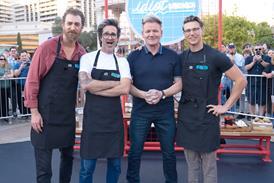With barriers to production beginning to be overcome, the 2014 World Cup final in Rio could be the first major event captured in 4K.

This time last year, few people were seriously considering live 4K, and the term Ultra-HD hadn’t moved beyond the chief engineers and academics who sit on standards bodies. Yet in a form 16 times the resolution of HD 1080i, not only is Ultra-HD concentrating the resources of broadcasters, satellite operators, OB suppliers and manufacturers, but the timetables for 4K broadcasts keep advancing.
Indeed, kick-off could be as soon as next summer, with the signs suggesting that, at the very least, the 2014 Fifa World Cup final will be captured in the format. “It’s highly probable,” says Benoit Fouchard, chief strategy officer at French compression specialist Ateme.
“There’s no doubt that at least one or two flagship games will be aired in 4K.” “There is no more prominent event than a World Cup if you are going to be pushing new technology, so it’s feasible we’ll see 4K live in 2014,” adds Futuresource Consulting head of broadcast equipment Adam Cox.
The barriers to production are beginning to be overcome and there’s no practical reason why Ultra-HD cannot be delivered live by satellite today (see box). Although there are significant gaps to address, the case for pioneering an Ultra-HD experience around the World Cup are compelling enough for Fifa to ensure it will happen. For a start, there’s the kudos Fifa would gain in breaking new production ground. Its track record in this regard includes sanctioning the first all-HD finals in 2006 and the capture and TX of 25 matches in 3D from South Africa 2010.
As with 3D (which, incidentally, Fifa has yet to commit to), production teams may have to adjust the editorial practice – such as making fewer cuts – to accommodate the greater visual information of the 4K picture. While Fifa’s priority will be coverage in HD – even while the bulk of the tournament’s 3.2 billion TV viewers still watch in SD– the sports body will take its cue for Ultra-HD from 2014 rights holders and from Sony.
Among the former is TV Globo, the Brazilian pay-TV giant with exclusive domestic rights to the World Cup and shared rights to the 2016 Rio Olympics. It has been trialling Ultra-HD in anticipation of both events for two years, shooting the Rio carnival with Sony’s F65 camera in 2012 and 2013.
Interest may also come from French national broadcaster France Télévisions, which, with Ateme, GlobeCast and Orange, is part of 4EVER, a French government-backed scheme to investigate Ultra-HD. France Télévisions content, including the 2012 French Tennis Open, forms part of rolling test transmissions on the 4K channel of French satellite provider Eutelsat.
The Japanese government’s decision to bring forward the scheduled launch of a 4K service from 2016 to July 2014 is another significant pointer. It hopes consumer interest in the World Cup will translate into flat panel sales to boost the flagging fortunes of economic powerhouses Sony and Panasonic.
While most Ultra-HD TVs incorporate technology to upscale HD pictures to pseudo-4K resolutions, the logical conclusion to draw from the Japanese initiative is that some matches next summer will be produced and aired natively in 4K.
For Sony, on the other hand, Ultra- HD (the company prefers to badge it 4K) is vital to turning around a TV business that has lost money for eight consecutive years and contributed to the company’s mammoth £3.6bn loss in 2011.
Must-have experience
Having developed the widest range of 4K hardware on the market, from professional cameras to consumer displays, few vendors have as much to gain as Sony from promoting Ultra-HD as the new ‘must-have’ viewing experience.
2014 is also the last year of Sony’s eight-year, $305m (£203m) sponsorship of Fifa, and its professional services arm is the primary technical partner for Fifa’s host broadcaster HBS at next year’s tournament. Having spent millions to underwrite the separate 3D production in South Africa, a precedent has been set for a parallel experiment in 4K.
Sony is already supplying OB facilities to HBS, including 340 HD cameras, 48 switchers and 72 slo-mos, and it wouldn’t be a stretch to add a few of its new 4K PVM-X300 production monitors and F65 cameras, which have already been tested by Fox Sports, ESPN, Sky Deutschland, SIS LIVE and BSkyB.
However, the F65, and Sony’s 4K F5 and F55 camcorders, are designed for digital cinema and the technology has yet to fi lter through to the 2/3-inch systems or studio cameras necessary for live TV. With NAB around the corner, it wouldn’t be a surprise if Sony were to unveil a roadmap for such models.
There is another issue though. “There’s no industry standard interface that can handle the bandwidth of baseband 4K, although there are some workarounds, so the very fabric of an OB production isn’t in place yet,” says Cox. The industry is looking to bodies such as SMPTE and the DVB to develop this.
While the number of households with Ultra-HD TV sets capable of receiving the feed is expected to be minuscule (just 123,000 in the UK by 2016, predicts Futuresource), it could be that select matches from Brazil are beamed to cinemas – as happened with the 3D feed in 2010 – provided rights to air a 4K feed are in place.
This time around, Sony has an even greater vested interest since its 4K digital cinema projection system is installed in 14,000 screens worldwide. It also markets a 4K home projector.
Other parts of the Ultra-HD live production are becoming feasible. Japanese broadcaster SKY Perfect Jsat has trialled 4K at football matches using equipment from EVS, which will provide the core workflow, server and replay systems to HBS. Announcements from Fifa are believed to be imminent but while any portion of the World Cup shot in 4K would be a milestone, it will be a sideshow to the main coverage mixed from 34 cameras per match.
“It probably won’t be the most breathtaking experience for fans simply because there won’t be enough 4K cameras trained on the action,” says Fouchard. “The multiple camera angles, slow-motion replays and even the commentary teams with which viewers are familiar won’t be available to the 4K production next year.”
Ultra-HD The Distribution Challenge
Satellite broadcasters are best placed to meet the bandwidth demands of a 4K picture (3,840 x 2,160 pixels), four times that of 1080p – once considered the next step in broadcast quality.
Eutelsat’s test channel comprises four HD channels (QuadHD), where HD is compressed in MPEG4. If that were to launch commercially today, it would cost a broadcaster $2-3m (£1.3-2m) a year, compared with $400,000-500,000 a year for an HD channel.
Bandwidth constraints mean Japan’s 4K service will be delivered over dedicated communications satellites rather than commercial broadcast ones, which are planned to follow later.
What will make Ultra-HD commercially viable is the HEVC codec, ratifi ed by the ITU in January. It’s expected to reduce the amount of data to rates similar to the levels of the first HD channels.
Receiving Eutelsat’s QuadHD 4K broadcasts over existing Ultra- HD displays is only possible by routing the signal through four receivers – and even then the picture may not be synchronised.
Receiving 4K broadcasts compressed in HEVC requires broadcaster investment in new set-top boxes. Deloitte says these would need larger hard drives to cope with bigger fi le sizes. Set-top boxes might need about 4TBs of storage, though by 2015, harddisk storage prices may have fallen to about $15 per TB.
Broadcom announced a 4K HEVC decoding chip at CES. This supports up to 24Hz and could soon be available in prototype STBs.
4K is not only a matter of spatial resolution. Fast-paced sports shot in 4K have been demonstrated to produce a blurring visual effect at 25Hz. The solution is to increase the frame rate of capture and display to a minimum of 60fps. While there are Ultra-HD sets capable of refreshing at 120Hz and higher, these will only accept HD content at such frame rates by interpolating the frames (where the native frame rate is halved). “Nobody wants to do less than 60fps for sport, but no one can do more at this stage,” says Benoit Fouchard of compression specialist Ateme.
The Ultra-HD specifi cation includes provision for even higher resolutions, such as Japanese broadcaster NHK’s 8K Super Hi- Vision – under investigation for a decade. The impetus behind 4K broadcasts has prompted it to step up plans for a domestic launch over satellite from 2020 to 2016, timed for the Rio Games.


























1 Readers' comment